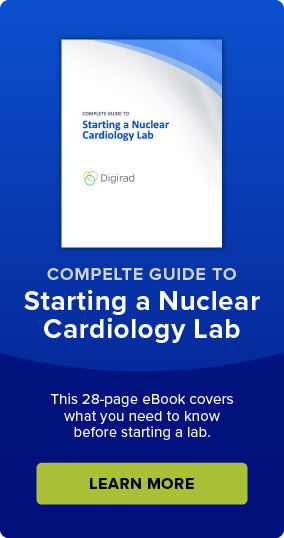After several years of reduced reimbursements and decreasing volumes, SPECT imaging has stabilized and is primed for growth. Digirad recently spoke with Kathy Flood, CEO of the American Society of Nuclear Cardiology, to get her viewpoint on SPECT imaging and where the modality is headed.
“Volumes are not dropping as dramatically as they were in the past,” she said, “one factor in this is that people are recognizing the value of nuclear cardiology, and secondly we’re seeing increases due to the implementation of appropriate use criteria.” ASNC has supported their members with increased education on appropriate use, which is helping. But, looking down the road, the applications for SPECT nuclear are beginning to grow.
SPECT Applications for Cardiac Amyloidosis
One of those new applications involves cardiac amyloidosis. In the past, a cardiac amyloidosis diagnosis could only be confirmed with a cardiac biopsy. And still, there was no available treatment. Now, a nuclear scan using technetium-99m pyrophosphate (Tc 99m PYP) is almost as effective as a cardiac biopsy.
With treatment drugs in the pipeline, there’s an exciting opportunity for nuclear imaging to play a significant role in both the diagnosis and management of the disease.
The availability of new treatments has heightened the importance of awareness, early diagnosis, and accurate typing of cardiac amyloidosis. In response, ASNC is working on an educational campaign that focuses on PYP imaging for patients with suspected cardiac amyloidosis.
New Educational Initiatives
ASNC’s annual Nuclear Cardiology Today Event, scheduled for April 12-14, 2019, will include a practical workshop on cardiac amyloidosis where not only nuclear cardiologists, but also referring physicians can learn about the disease.
The half-day, case-based program will address the diagnosis and management, tackle the challenges of disease presentation, discuss the role of various imaging modalities in the diagnosis, and give an overview of current and emerging treatments.
Cardiac amyloidosis is considered a rare and potentially under-diagnosed disease. One of the contributing factors is that its symptoms closely resemble heart failure. As statistics say that about 30% of heart failure patients have been misdiagnosed and that heart failure is the number one disease state where Medicare spends money, that equates to a lot of patients.
“Our goal is to make our members and referring physicians aware of cardiac amyloidosis, about the role of nuclear cardiology, and how to provide high-quality imaging around that for decision making and treatment,” said Flood.
ASNC also plans to offer more hands-on simulation opportunities at their meetings so that members can network with experts in their field, better understand how they’re performing nuclear cardiology, and learn how they can improve. Taking those experiences back to their labs will help them provide the best images for their patients.
Investing in the Next Generation
Looking ahead, ASNC is intent on making sure their members have what they need, but they’re also making investments in the new generation. “We’re working to put together programs specifically for the cardiology fellowship training programs. We want to be able to either help supplement some of the nuclear education they receive, or if they don’t receive any, be able to direct them to ASNC,” said Flood.
SPECT remains the most common procedure in nuclear cardiology, but the younger generation tends to focus on the newer modalities, like Cardiac CT. Once they graduate, they’re often unable to use this knowledge in practice because the new modalities are not as widespread in the field. That’s when they look back and wish they would have spent more time on SPECT imaging.
“We’re trying to fill that void as we move forward over the next couple of years so we have more programs and touch points with fellows in training so they can get just as excited about nuclear, too,” said Flood.



